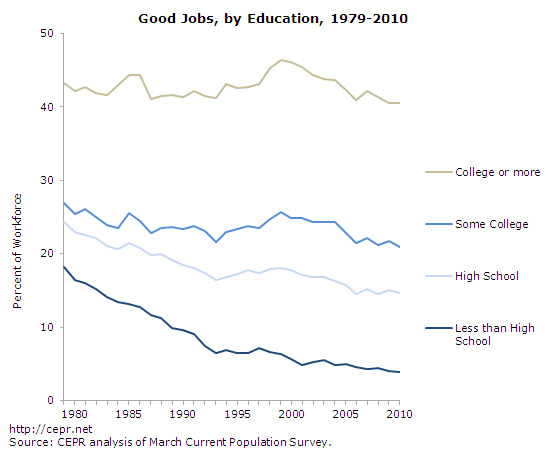August 08, 2012
Over the last few days, several blogs have commented on the chart below from a recent CEPR report (pdf) that Janelle Jones and I did on “Good Jobs.” (See, for example, Kevin Drum, Brad Plumer at WonkBlog, Andrew Sullivan, and ThinkProgress.)
The graph shows that over the last three decades the share of college-educated workers with what we define as a good job –one that pays at least $37,000 a year, has employer-provided health insurance, and an employer-sponsored retirement plan– has actually declined slightly.
The graph also shows that over the same period, the drop in good jobs was even steeper for those with less education. But, what we and most of those commenting have focused on is the decline in good jobs experienced even by the best-educated part of the workforce. This group has “done the right thing” by the labor market, but is, nevertheless, now less likely to have a good job than was the case back in 1979.
Given the interest in “good job” trends by education, we thought we’d produce similar graphs showing the trends in the share of workers that separately meet each of the three underlying criteria. These graphs give a fuller picture of the forces driving the fall in good jobs within the education categories.
The first figure gives the share of workers in each education category that earns at least $37,000 per year (in inflation-adjusted 2010 dollars). By this measure, the situation of college graduates improved noticeably. About 73 percent of college graduates made at least $37,000 per year in 2010, up from 64 percent in 1979. Even workers with only some college did somewhat better on the wage front, with 43 percent above the threshold in 2010, compared to 41 percent in 1979. High school and less than high school educated workers, however, lost ground. The loss was relatively small for those with a high school degree (down from 36 percent in 1979 to 32 percent in 2010) and much larger for those with less than a high school degree (from 27 percent in 1979 to 13 percent in 2010).
The second figure illustrates the real problem: the decline in employer-provided health insurance. College-educated workers saw their likelihood of having employer-provided health insurance fall from 79 percent in 1979 to 70 percent in 2010. Once again, the drop-off in coverage was worse for those with less education: a 14 percentage-point decline, to 55 percent, for workers with some college; a 19 percentage-point decline, to 50 percent for those with a high school degree; and a 33 percentage-point decline, to 29 percent, for those without a high-school degree. The figure suggests that the single biggest cause of the decline in “good jobs,” then, was the collapse in employer-provided health insurance. As a result, the full implementation of the Affordable Care Act could substantially improve the job-quality picture moving forward.
The final figure shows another contributing factor: a drop in the share of workers with employer-sponsored retirement plans (anything from a traditional pension to a 401(k)-type plan). The share of college-educated workers with a retirement plan fell from 65 percent in 1979 to 60 percent in 2010. Retirement-plan coverage fell even more for the other education groups: from 50 percent to 44 percent for those with some college; from 51 percent to 37 percent for those with a high school degree; and from 43 percent to just 17 percent for those with less than a high school degree. And, as my colleague Janelle Jones pointed out in a recent CEPR blog post, the quality of retirement plans also deteriorated sharply over this period, with a big shift away from traditional pensions in favor of riskier, not to mention less generous, 401(k)-style plans.










